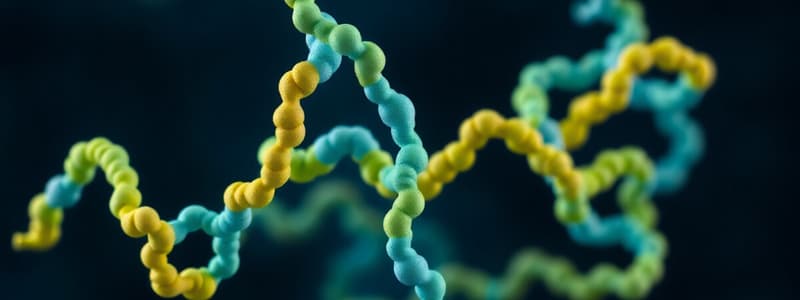Podcast
Questions and Answers
What are amino acids?
What are amino acids?
The fundamental units of proteins that yield proteins through polymerization.
How many amino acids are identified in nature?
How many amino acids are identified in nature?
More than 300 amino acids have been identified.
All amino acids have different fundamental structures.
All amino acids have different fundamental structures.
False (B)
Which of the following is NOT a classification scheme for amino acids?
Which of the following is NOT a classification scheme for amino acids?
Which of the following amino acids is classified as essential?
Which of the following amino acids is classified as essential?
What are non-essential amino acids?
What are non-essential amino acids?
The six conditional amino acids include cysteine, arginine, tyrosine, glutamine, ornithine, ______, and proline.
The six conditional amino acids include cysteine, arginine, tyrosine, glutamine, ornithine, ______, and proline.
How many essential amino acids are there?
How many essential amino acids are there?
All amino acids occurring in proteins are of the D-form.
All amino acids occurring in proteins are of the D-form.
Flashcards
Amino Acids
Amino Acids
The fundamental building blocks of proteins.
Essential Amino Acids
Essential Amino Acids
Amino acids the body cannot produce and must obtain from food.
Nonessential Amino Acids
Nonessential Amino Acids
Amino acids the body can produce itself.
Conditional Amino Acids
Conditional Amino Acids
Signup and view all the flashcards
Peptide Bonds
Peptide Bonds
Signup and view all the flashcards
L-form amino acids
L-form amino acids
Signup and view all the flashcards
20 amino acids
20 amino acids
Signup and view all the flashcards
Amino Acid Structure
Amino Acid Structure
Signup and view all the flashcards
Glycine
Glycine
Signup and view all the flashcards
α-carbon
α-carbon
Signup and view all the flashcards
Study Notes
Biochemistry Lecture: Chemistry of Protein and Amino Acids
- Proteins are composed of amino acids
- Over 300 amino acids exist in nature, but only 20 are used to create all body proteins
- These 20 are specified by the genetic code
- All amino acids share a similar fundamental structure but have different side chains
- These side chains influence polarity, charge, molecular weight, and function
- Peptide bonds join amino acids to form polypeptide chains
- These chains fold into secondary and tertiary structures that determine protein function
- Lean beef (150g raw) contains 33g of protein
- Chicken (150g raw) contains 33g of protein
- White fish (150g raw) contains 30g of protein
- Tuna (95g can) contains 19g of protein
- Milk (1 cup) contains 10g of protein
- High protein milk (1 cup) contains 15g of protein
- Tofu (100g) contains 12g of protein
- Mixed nuts (30g) contains 7g of protein
- High protein yoghurt (170g) contains 15g of protein
- Cheese (35g) contains 9g of protein
- Eggs (1 large) contain 8g of protein
- Legumes (½ cup) contain 7g of protein
Amino Acids
- Amino acids are the building blocks of proteins
- Their basic structure includes an amino group, a carboxyl group, and a side chain (R group)
- The R group gives each amino acid its unique properties
- Peptide bonds link amino acids together to form polypeptide chains
- The sequence and arrangement of these amino acids determine the final shape of a protein
Stereochemistry of Amino Acids
- Most amino acids found in proteins have an L configuration
- The only exception is glycine, which is not optically active
- The L-form is opposite to the D-form, found in some bacterial products
Classification of Amino Acids
- Amino acids can be classified based on different criteria:
- Structure of their side chains (nonpolar, polar, electrically charged)
- Polarity and charge of the R group
- Catabolic fate of the amino acid
- Ability of the body to synthesize the amino acid
Types of amino acids
- Essential Amino Acids: Cannot be synthesized by the body and must be obtained from the diet
- Examples: leucine, isoleucine, histidine, lysine, methionine, threonine, phenylalanine, tryptophan, and valine
- Non-Essential Amino Acids: Synthesized by the body and are not crucial to obtain from the diet
- Examples: arginine, alanine, aspartic acid, asparagine, cysteine, glutamine, glutamic acid, proline, glycine, serine and tyrosine
- Conditional Amino Acids: Usually not essential, but become essential in times of illness, injury, or during periods of rapid growth (like in prematurity)
- Examples: cysteine, arginine, tyrosine, glutamine, ornithine, glycine, serine, and proline
Studying That Suits You
Use AI to generate personalized quizzes and flashcards to suit your learning preferences.




